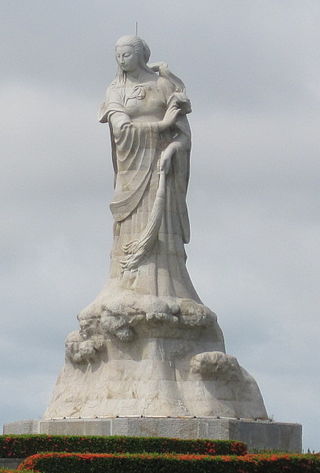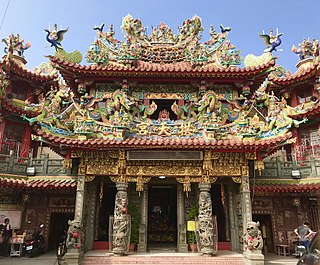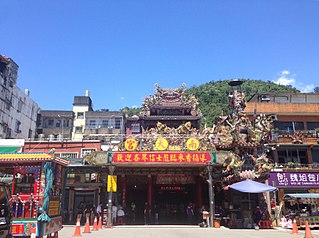
Mazu or Matsu is a Chinese sea goddess in Chinese folk religion, Chinese Buddhism, Confucianism, and Taoism. She is also known by several other names and titles. Mazu is the deified form of Lin Moniang, a shamaness from Fujian who is said to have lived in the late 10th century. After her death, she became revered as a tutelary deity of Chinese seafarers, including fishermen and sailors. Her worship spread throughout China's coastal regions and overseas Chinese communities throughout Southeast Asia, where some Mazuist temples are affiliated with famous Taiwanese temples. Mazu was traditionally thought to roam the seas, protecting her believers through miraculous interventions. She is now generally regarded by her believers as a powerful and benevolent Queen of Heaven.

Taichung, officially Taichung City, is a special municipality in central Taiwan. Taichung is Taiwan's second-largest city, with more than 2.85 million residents, making it the largest city in Central Taiwan. It serves as the core of the Taichung–Changhua metropolitan area, Taiwan's second-largest metropolitan area.

Putian, also known as Puyang (莆阳) and Puxian (莆仙), historically known as Xinghua, is a prefecture-level city in Fujian Province, People's Republic of China. It borders Fuzhou to the north, Quanzhou to the south, and the Taiwan Strait's Xinghua Bay to the east. Mulan River flows through the city.

Dajia District is a coastal suburban district in Taichung, Taiwan. It is located on the northwestern corner of Taichung. The climate of the region is Sub-tropical, and the average temperature is roughly 24 degrees Celsius. In March 2012, it was named one of the Top 10 Small Tourist Towns by the Tourism Bureau of Taiwan.
Articles related to Taiwan include:

Dajia is a railway station on the Taiwan Railways Administration (TRA) West Coast line located in Dajia District, Taichung, Taiwan.

Yongchun is a county in western Quanzhou city of southern Fujian province, People's Republic of China, located on the upper reaches of the Jin River. It is under the administration of Quanzhou City. As of 2009, it had a total population of 558,996 residing in an area of 1,469 square kilometres (567 sq mi).

Xingang Township or Singang Township is a rural township in Chiayi County, Taiwan.

Yen Ching-piao is a Taiwanese politician.

The Baishatun Mazu Pilgrimage is usually held annually between lunar January and April in the western plains of Taiwan, a major Taoist religious event since 1863. After every lunar new year, the Mazu statue of Gongtian Temple at Baishatun, Tongxiao of Miaoli County, is placed in a palanquin and carried in procession to visit another Mazu Temple- Chaotian Temple, located in the area of Beigang of Yunlin County, then returns to Gongtian Temple to end this pilgrimage. The distance covered is approximately 400 km total.

Zi Yun Yan, alternatively romanized as Tzu Yun Yen, is a temple located in Qingshui District, Taichung, Taiwan. The temple is dedicated to Guanyin.

Bengang Tianhou Temple is a temple located in Nangang Village, Xingang Township, Chiayi County, Taiwan. Sitting on the south shore of the Beigang River, the temple is dedicated to Mazu, Goddess of Sea.

Baishatun Gongtian Temple is a temple located in Baishatun, Tongxiao Township, Miaoli County, Taiwan. The temple is dedicated to the sea goddess Mazu, who is the deified form of Lin Moniang. Gongtian Temple is noted for its annual Baishatun Mazu Pilgrimage, where worshippers travel to Chaotian Temple in Beigang, Yunlin on foot.

Dazhuang Haotian Temple is a temple located in Dazhuang, Wuqi District, Taichung, Taiwan. The temple is dedicated to the sea goddess Mazu.

Nanfang'ao Nantian Temple is a temple dedicated to the sea goddess Mazu in Nanfang'ao, Su'ao Township, Yilan County, Taiwan.

The Dajia Mazu Pilgrimage is an annual celebration of the Taoist sea goddess Mazu held in Taiwan. During the festival, a statue of Mazu is placed in a litter and carried by foot on a round-trip journey from Jenn Lann Temple in Dajia, Taichung to Fengtian Temple in Xingang, Chiayi, stopping at many more temples along the way. The festival lasts for nine days and attracts large crowds of pilgrims. Every year during the event, the Departments of Environmental Protection from the local counties send many volunteers and cleaners to remove the litter alongside the route.

Xingang Fengtian Temple, sometimes romanized as Fongtian Temple, is a temple located in Xingang Township, Chiayi County, Taiwan. The temple is a county-level monument and the destination of the annual Dajia Mazu Pilgrimage.

























